Keith Walker - Steam Train Photography With A Leica M
05th September 2025
In: News, Members' Articles
Keith Walker - Steam Train Photography With A Leica M
From images Ken has kindly used on the Fellowship Website, you may have noticed I like photographing steam trains, so I thought it might be of interest as to how this came about.
For my generation in the late 50’s and through into the 60’s life revolved around your bike, as it gave you the means to get anywhere. Weekends, summer evenings and school holidays it was off to meet my friends to play improvised sport or the game of the season (remember conkers). The fall back position was “trainspotting” i.e.
collecting the numbers allocated to locomotives, in various locations. I grew up in Weymouth, Dorset, where my father was a Customs Officer based at Weymouth Quay. Back then Weymouth Quay was busy with both imports (mostly fresh produce) from the Channel Islands and Brittany, as well as passengers using boats run by British Rail to both Guernsey and Jersey.
Many passengers arrived by ‘Boat Train’ from London termini. Back then there was a famous ’tramway’ that ran from the station and around the town to both a freight and passenger station on the Quay. The smell of the oil tanker wagons that serviced the boats is ingrained in my nostrils!
Weymouth Railway Station was also a terminus for both Great Western
Railway and Southern Railway trains. The two Regions shared a large
marshalling yard, engine shed and coaling facility.. The shed was a mile or so from the station and was a bit of a magnet for us as it was always busy servicing loco’s from both Regions and a good place to see all newly arrived engines.
I had no camera at that time, but we had books listing all locomotive numbers and names by Class, and carefully underlined the engines we had seen (‘coped’ in youth speak). Unfortunately the books were thrown away at some point!
Being a seaside and holiday resort on summer Saturdays and Sundays there were several train excursions from Bristol and Cardiff.Trains leaving Weymouth faced a steep gradient for around four miles to Bincombe Tunnel. The ‘rules’ dictated that over a certain number of coaches trains had to be ‘double headed’ (two engines at
the front), and a couple more coaches required an engine at the rear also (a banker) to ensure adequate power for the climb. It was also a four mile cycle ride to get to the top of the climb, but the reward was the sight and sound of two or three engines working flat out which was quite a spectacle, with the added bonus that the visiting
engines may be a new sighting.
Time and life moved on and train spotting became but a fond memory.
Decades later I started buying the odd photobook of the railways back in the days of steam and was frankly impressed by the quality of the pictures, the majority of which were black and white. Steam powered locomotives had disappeared from use on the rail network by the late 60’s but I knew some were retained in preservation. The closure of many branch lines also enabled a number of enthusiast run ‘heritage’ railways to be opened around the country using the original track bed.
I had become seriously into photography in my mid-teens and on retirement it was to be a major focus (excuse pun). Standard advice if you want to give your photography a boost is to find a project. So, as a project I decided I would like to put together a (Blurb) book replicating the railway photobooks I had enjoyed.We had just moved house and as part of the move abandoned the darkroom
so it would have to be digital capture. However, I decided I would forgo the adage of ‘best tool for the job’ and use only my M bodies and prime lenses without autofocus and image stabilisation, as would have been used back in the day.
Over the past fifteen years I have visited most of the heritage railways that run engines of the type that visited Weymouth. All the railways run one or two Gala events a year with visiting engines with a more intense timetable, and which therefore provides greater opportunity for photography. These events also often include
demonstration freight trains. I also found there were photographic charter events that also provided excellent opportunities.
For my railway photography, camera exposure time is set manually using a fast enough shutter speed to ‘freeze’ a moving train and an aperture with a sufficient depth of field, and an ISO that will provide an exposure that will not ‘blow’ the highlights, and then by pre-focus on the spot on the track where I wanted the engine to be in the image and holding your breath! Just standard camera technique.
Success came in the form of not one but two Blurb books, and I am now
toying with a third. Images I have taken have also been used on the cover of a magazine, in magazine double page spreads and also on a calendar. Do I hear sad?
The Railways used for my photographic efforts are:-
The Swanage Railway
The Mid-Hants Railway (Watercress Line)
The Severn Valley Railway
The West Somerset Railway
The East Somerset Railway
Paignton to Kingswear Railway
The South Devon Railway
Didcot Railway Centre
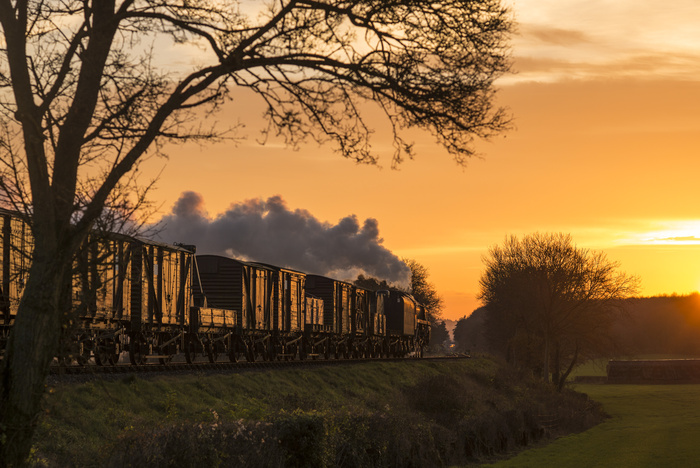
Alersford Sunset Mid-Hants Railway

Corfe Castle Station, Swanage Rly
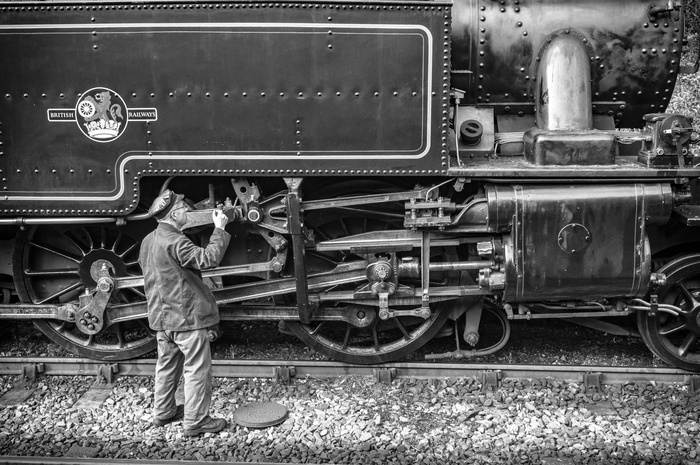
Maintenance, Ropley Station Mid-Hants Railway
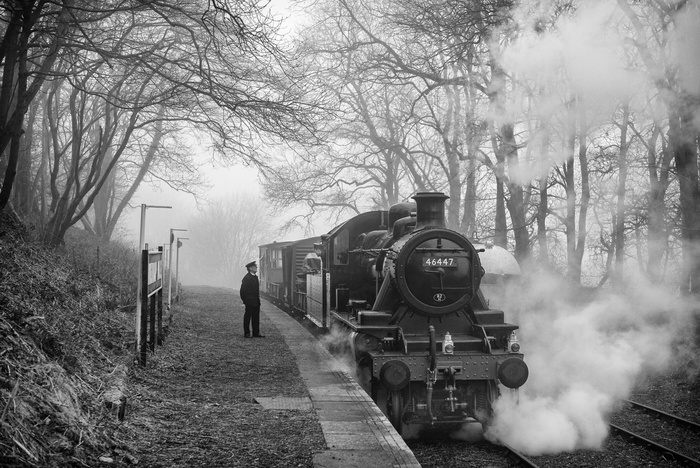
Mendip Vale - East Somerset Railway
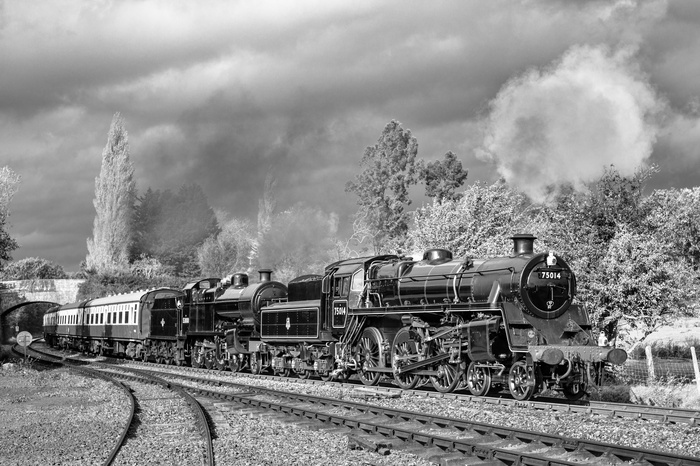
Nr. Bishops Lydiard, West Somerset Railway
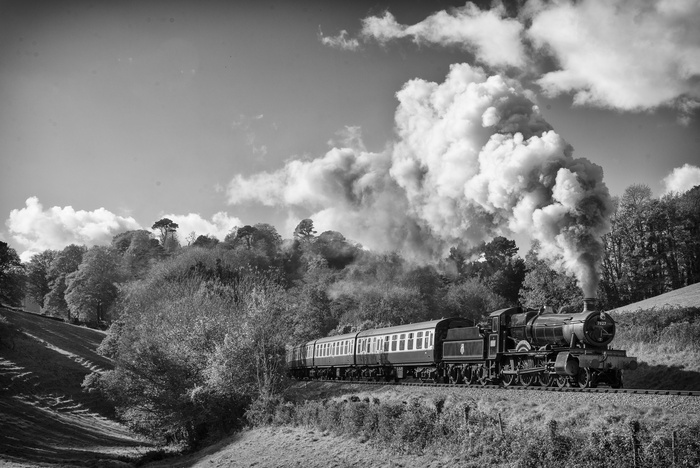
Near Kingswear
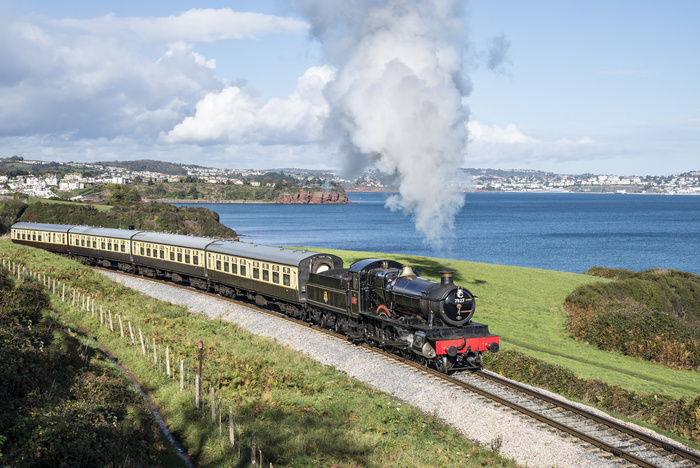
Paigton
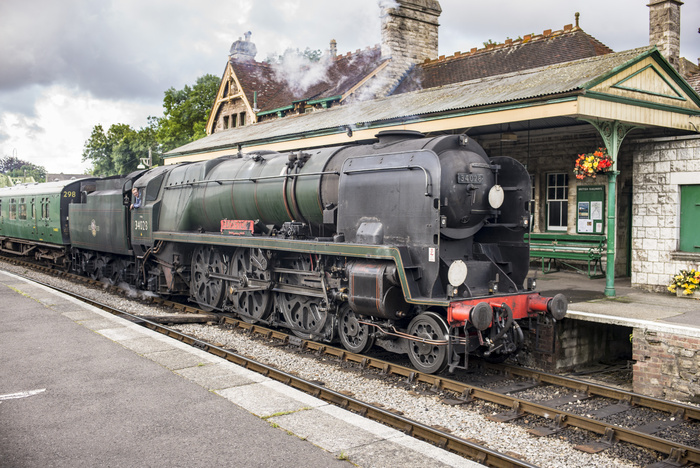
Simmering, Corfe Castle Station, Swanage Rly

Evening, Staverton Station
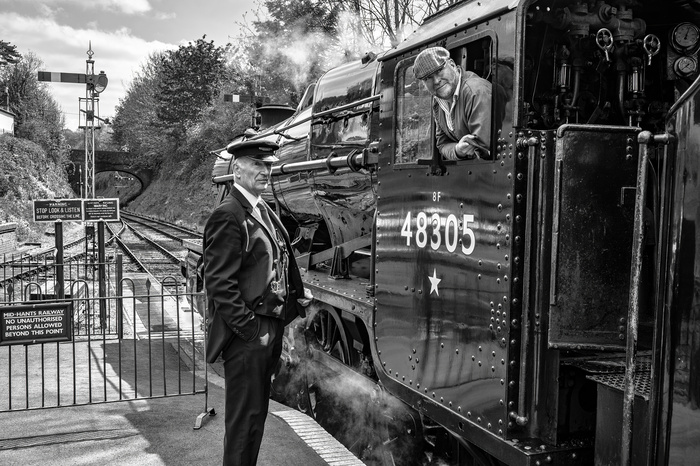
Proud Railwaymen, Alersford Station
From images Ken has kindly used on the Fellowship Website, you may have noticed I like photographing steam trains, so I thought it might be of interest as to how this came about.
For my generation in the late 50’s and through into the 60’s life revolved around your bike, as it gave you the means to get anywhere. Weekends, summer evenings and school holidays it was off to meet my friends to play improvised sport or the game of the season (remember conkers). The fall back position was “trainspotting” i.e.
collecting the numbers allocated to locomotives, in various locations. I grew up in Weymouth, Dorset, where my father was a Customs Officer based at Weymouth Quay. Back then Weymouth Quay was busy with both imports (mostly fresh produce) from the Channel Islands and Brittany, as well as passengers using boats run by British Rail to both Guernsey and Jersey.
Many passengers arrived by ‘Boat Train’ from London termini. Back then there was a famous ’tramway’ that ran from the station and around the town to both a freight and passenger station on the Quay. The smell of the oil tanker wagons that serviced the boats is ingrained in my nostrils!
Weymouth Railway Station was also a terminus for both Great Western
Railway and Southern Railway trains. The two Regions shared a large
marshalling yard, engine shed and coaling facility.. The shed was a mile or so from the station and was a bit of a magnet for us as it was always busy servicing loco’s from both Regions and a good place to see all newly arrived engines.
I had no camera at that time, but we had books listing all locomotive numbers and names by Class, and carefully underlined the engines we had seen (‘coped’ in youth speak). Unfortunately the books were thrown away at some point!
Being a seaside and holiday resort on summer Saturdays and Sundays there were several train excursions from Bristol and Cardiff.Trains leaving Weymouth faced a steep gradient for around four miles to Bincombe Tunnel. The ‘rules’ dictated that over a certain number of coaches trains had to be ‘double headed’ (two engines at
the front), and a couple more coaches required an engine at the rear also (a banker) to ensure adequate power for the climb. It was also a four mile cycle ride to get to the top of the climb, but the reward was the sight and sound of two or three engines working flat out which was quite a spectacle, with the added bonus that the visiting
engines may be a new sighting.
Time and life moved on and train spotting became but a fond memory.
Decades later I started buying the odd photobook of the railways back in the days of steam and was frankly impressed by the quality of the pictures, the majority of which were black and white. Steam powered locomotives had disappeared from use on the rail network by the late 60’s but I knew some were retained in preservation. The closure of many branch lines also enabled a number of enthusiast run ‘heritage’ railways to be opened around the country using the original track bed.
I had become seriously into photography in my mid-teens and on retirement it was to be a major focus (excuse pun). Standard advice if you want to give your photography a boost is to find a project. So, as a project I decided I would like to put together a (Blurb) book replicating the railway photobooks I had enjoyed.We had just moved house and as part of the move abandoned the darkroom
so it would have to be digital capture. However, I decided I would forgo the adage of ‘best tool for the job’ and use only my M bodies and prime lenses without autofocus and image stabilisation, as would have been used back in the day.
Over the past fifteen years I have visited most of the heritage railways that run engines of the type that visited Weymouth. All the railways run one or two Gala events a year with visiting engines with a more intense timetable, and which therefore provides greater opportunity for photography. These events also often include
demonstration freight trains. I also found there were photographic charter events that also provided excellent opportunities.
For my railway photography, camera exposure time is set manually using a fast enough shutter speed to ‘freeze’ a moving train and an aperture with a sufficient depth of field, and an ISO that will provide an exposure that will not ‘blow’ the highlights, and then by pre-focus on the spot on the track where I wanted the engine to be in the image and holding your breath! Just standard camera technique.
Success came in the form of not one but two Blurb books, and I am now
toying with a third. Images I have taken have also been used on the cover of a magazine, in magazine double page spreads and also on a calendar. Do I hear sad?
The Railways used for my photographic efforts are:-
The Swanage Railway
The Mid-Hants Railway (Watercress Line)
The Severn Valley Railway
The West Somerset Railway
The East Somerset Railway
Paignton to Kingswear Railway
The South Devon Railway
Didcot Railway Centre

Alersford Sunset Mid-Hants Railway

Corfe Castle Station, Swanage Rly

Maintenance, Ropley Station Mid-Hants Railway

Mendip Vale - East Somerset Railway

Nr. Bishops Lydiard, West Somerset Railway

Near Kingswear

Paigton

Simmering, Corfe Castle Station, Swanage Rly

Evening, Staverton Station

Proud Railwaymen, Alersford Station
Comments
 By Cled Lewis: Hello Keith,
What a great description of your early interest in railways which has resonated with so many of us. You have captured the atmosphere of the times and your photographs have been chosen with care and are all winners.
My favourite is Evening at Staverton Station .
Thank you .
Cled
By Cled Lewis: Hello Keith,
What a great description of your early interest in railways which has resonated with so many of us. You have captured the atmosphere of the times and your photographs have been chosen with care and are all winners.
My favourite is Evening at Staverton Station .
Thank you .
Cled By Alan Humphies: Thank you Keith for a wonderful piece will bring back similar memories for many Fellowship Members. Mine like yours start with my bicycle, on which I visited Exmouth Station of course, plus Exeter Central and St.Davids, the jewel in the crown would have been to visit the maintenance and cleaning sheds at Exmouth Junction, unfortunately it wasn't accessible to school boys.
Smashing photos Keith,m you have certainly found your niche.
By Alan Humphies: Thank you Keith for a wonderful piece will bring back similar memories for many Fellowship Members. Mine like yours start with my bicycle, on which I visited Exmouth Station of course, plus Exeter Central and St.Davids, the jewel in the crown would have been to visit the maintenance and cleaning sheds at Exmouth Junction, unfortunately it wasn't accessible to school boys.
Smashing photos Keith,m you have certainly found your niche. By Barbara Fletcher: Thank you Keith for an excellent set of images encapsulating the energy and majesty of the age of steam. It is also a delight that your photography is done with an emotional empathy for both steam and all those individual that make this history available to us all.
I also appreciate the opportunity it has given me for personal nostalgia - the childhood freedom of the bicycle, collecting train numbers, getting pennies flattened by putting them on the rail track and catching the “Tetbury Flyer” from Kemble in the 1940s to stay at the family farm in the school holidays.
A very valued contribution Keith, thanks again
By Barbara Fletcher: Thank you Keith for an excellent set of images encapsulating the energy and majesty of the age of steam. It is also a delight that your photography is done with an emotional empathy for both steam and all those individual that make this history available to us all.
I also appreciate the opportunity it has given me for personal nostalgia - the childhood freedom of the bicycle, collecting train numbers, getting pennies flattened by putting them on the rail track and catching the “Tetbury Flyer” from Kemble in the 1940s to stay at the family farm in the school holidays.
A very valued contribution Keith, thanks again By Pam Lewis: Hi Keith
Once again a lovely set of pictures. I have never been quick enough to catch a train fully in camera
When our two sons were younger they used to like to go to Selby station in Yorkshire and do a little train spotting. The Blurb books are a good way to store pictures for posterity. I too have used blurb and found them very good. It is really nice to see your pictures in print and a good way to keep them safe. Well done Keith
By Pam Lewis: Hi Keith
Once again a lovely set of pictures. I have never been quick enough to catch a train fully in camera
When our two sons were younger they used to like to go to Selby station in Yorkshire and do a little train spotting. The Blurb books are a good way to store pictures for posterity. I too have used blurb and found them very good. It is really nice to see your pictures in print and a good way to keep them safe. Well done Keith By Don Morley: Wonderful Keith. Such evocative pictures. They certainly bring back so many nostalgic memories for me. Thank you, Don
By Don Morley: Wonderful Keith. Such evocative pictures. They certainly bring back so many nostalgic memories for me. Thank you, Don By David Askham: So very nostalgic, Keith. The images bring back to me the clinking of chains in the marshaling yards, and the unique blend of characteristic smells comprising carbon, smoke, grease and oil.
By David Askham: So very nostalgic, Keith. The images bring back to me the clinking of chains in the marshaling yards, and the unique blend of characteristic smells comprising carbon, smoke, grease and oil. By Keith Walker: Many thanks for your kind comments which are appreciated, and pleased it rekindled memories!
By Keith Walker: Many thanks for your kind comments which are appreciated, and pleased it rekindled memories! By Ken Davis: Keith, you show both the power of steam and the way that heritage centres preserve these important machines. The many comments show what we think of your photos. Good work. Ken
By Ken Davis: Keith, you show both the power of steam and the way that heritage centres preserve these important machines. The many comments show what we think of your photos. Good work. Ken